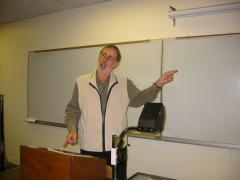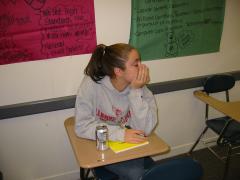
Psychology Depart. - DeGarmo Hall
Epistemological Development in College Students: A Longitudinal Investigation
Patricia A. Jarvis
Gary L. Creasey
Leatrice R. Brooks

This is so interesting! I can see how it could be either nature or nurture.
Literature Review
Most experts intuitively believe that debate and cognitive dissonance are a first step in encouraging students to think critically, as well as debate. Exactly how instructors introduce curriculum to do this is up to the individual; however when discussing these issues with instructors at our institution, most introduced a controversial historical event, such as the Vietnam War, or societal issue, such as abortion rights as a theme that is discussed and debated throughout the semester. This tact is not local to our institution; a visit to course syllabi posted on the Internet revealed that this strategy is widely used in similar gateway courses across the country.
While our attempts to encourage debate, dissonance, and critical thinking in young (usually), impressionable minds is admirable, for the most part, it is very hard-pressed to see much attention to the developmental status of most of our college students. That is, at most institutions, our students are late adolescents; these youth are on an obviously different intellectual and developmental plane from their instructors, as well as the brainchildren of these freshmen gateway courses. Is this an issue that should cause us as educators any concern?
To shed more light on this issue, we considered a popular theoretical model of adolescent analytical reasoning (Klaczynski, 2000). There are theoretical elements of this approach that are very consistent with what educators posit; that is, consistent with the conceptual framework, many educators assume that the development of critical thinking is spurred by cognitive dissonance. However, this framework also posits that not all adolescents engage in analytical thinking when challenged. For instance, although cognitive dissonance and debate are claimed to “shake up” low-level belief systems in adolescent learners, the theoretical framework, and other conceptual frameworks explaining the development of adolescent analytical reasoning (Kuhn et al., 1995) suggest this is a very untenable assumption that is not supported by contemporary theory or research. Indeed, as illustrated in the theoretical framework, cognitive dissonance and debate do not automatically spur critical thinking in these adolescents.
For instance, research suggests that adolescents, who hold low-level epistemological beliefs, when challenged, often engage in simple “heuristic”; processing relying on impressionism, intuitions, and “gut”; reactions. They often dismiss/ignore contradictory viewpoints that conflict with their personal theories (belief defensiveness) (Klaczynski, 2001, Reyna & Brainerd, 1995). Heuristic processing leads to rejection of evidence, and such learners simply preserve whatever theory they brought to task. Unfortunately many adolescents possess an educational background that has encouraged silence and lack of debate–an experience commonly witnessed by first generation students (Torff & Sternberg, 2001; Jarvis, Reese-Weber, & Creasey, 2002). These learners may be disadvantaged in two ways (Belenky et al., 1997). First, they may feel highly threatened by participating in a group setting; much less a group setting where older, educated adults attempt to encourage debate! Second, such learners often hold low-level epistemological beliefs; that is, they possess a high need for closure, a low tolerance for uncertainty, and strong desires for personal theory preservation (Klaczynski, 2000). Research has supported these points (Klaczynski, 2001; Kuhn, 1999), and well-reasoned argumentation and persuasion do not spur the development of critical thinking in this group of adolescents (Kruglanski et al., 1993). There is also evidence that males may hold more rigid belief systems than females; however, while some have documented this theory (Cote, 1996), others have not (Torney-Purta, 1990).

Now we will discuss the nature vs. nurture debate.
We conducted a longitudinal study in which the epistemological beliefs of freshmen students were assessed at two times of measurement (the first and last two weeks of classes).
Research Questions
Two primary questions were examined:
Do epistemological beliefs demonstrate improvement over time, evidencing the development of critical thinking in freshmen experience classes?
Is such growth is moderated by gender, given the controversial findings (Torney-Purta, 1990; Cote, 1996), regarding gender and epistemological beliefs?
Method
Participants: Students (n = 158) completed measures at two time points. The sample was representative of different: days of the week and times of day; level of instructor rank; student's majors; and traditional race and socio-economic status and demographic variables
Measures
All participants completed a demographic data sheet indicating:
age ethnicity
major gender
birth order
family demographics
(e.g., caregiver marital status, education, and occupation)
Participants completed the following widely used, epistemological belief scales:
Belief Defensiveness Scale (BD; Klaczynksi et al., 1998): The 17-item BD assesses one’s openness to belief revision.
Need for Closure Scale (NFCL; Kruglanski et al., 1993): This 42-item instrument assesses individual differences in the need for (or avoidance of) cognitive closure.
Need for Cognition Scale (NFC; Cacioppo & Petty, 1982): The 18-item NFC assesses the tendency to seek and enjoy challenging experiences.
Procedures
Students and instructors were informed that we were collecting routine data regarding their freshman orientation class experience and that data would not be reported by class but rather across classes.
Research assistants blind to the study hypotheses collected the data during the first and last two weeks of classes. Informed consent and data collection took place without the instructor in the room.

This is so boring. Everyone knows only one view is correct here.
Results
A 2(time) by 2(gender) MANOVA was conducted to examine the research questions.
The time effect was treated as a within subjects variable, and the three epistemological instruments were treated as a dependent variable set.
These analyses revealed that critical thinking improved over time, F(1, 156) = 137.62. p < .05, but need for closure and cognitive challenge did not change.
Thus, combating defensive beliefs must be achieved before higher order thinking is possible.
There were no significant gender effects.
Link to Table of Descriptive Data for Study Variables
Implications
1. As critical thinking improved over time, we have obtained important assessment data regarding our freshman experience course. However, some curriculum modifications are needed to address defensiveness of beliefs in students beginning college if they are to move to higher order thinking. Such work needs to be done early in the course in the freshmen year to pave the way for the development of analytical thinking.
2. We concur, based on our data, with experts who recommend that educators loosen rigid epistemological belief systems, and help adolescents feel comfortable working in open group settings, before moving into tasks/assignments that encourage major cognitive dissonance and argumentation.
Applications
There are a number of educational/ social psychological techniques assignments designed to address ideas presented by out data (Belenky et al., 1997), and such psycho-educational intervention is necessary because such learners who eventually develop flexible belief systems quickly abandon stereotypical personal theories, are comfortable with debate, and engage in analytical thinking when they experience cognitive dissonance (Klaczsinky, 2000). These achievements will bode well for students as they move through their college career and pursue learning as a life long endeavor.
References
This work is licensed under a Creative Commons License
This electronic portfolio was created using the KEEP Toolkit™, developed at the
Knowledge Media Lab of The Carnegie Foundation for the Advancement of Teaching.
Terms of Use - Privacy Policy